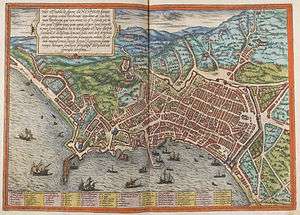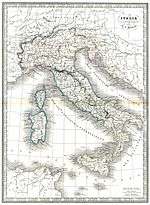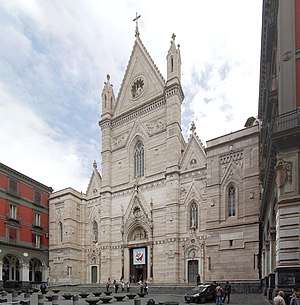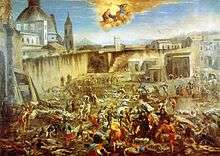Timeline of Naples
The following is a timeline of the history of the city of Naples. The Naples area has been inhabited since the Neolithic period. The earliest historical sources in the area were left by the Myceneans in the 2nd millennium BC. During its long history, Naples has been captured, destroyed and attacked many times. The city has seen earthquakes, volcanic eruptions, foreign invasions and revolutions.

Map of Naples, 1572

An 18th-century painting depicting an eruption of Mount Vesuvius.
Prior to 12th century
Part of a series on the |
||||||||||||||
|---|---|---|---|---|---|---|---|---|---|---|---|---|---|---|
| History of Italy | ||||||||||||||
 | ||||||||||||||
|
Early
|
||||||||||||||
|
||||||||||||||
|
Post-Roman Kingdoms
|
||||||||||||||
|
Medieval
|
||||||||||||||
|
Early modern
|
||||||||||||||
|
Modern
|
||||||||||||||
|
| ||||||||||||||
- 2nd millennium BC – first Mycenaean settlements established in the Naples area.[1]
- 8th century BC – Kyme (Cumae), established an epineion (out-port) named Parthenope.[2]
- 6th century BC – Parthenope was refounded as Neapolis.[3]
- 327 BC – Naples makes an alliance with Rome, and enters its sphere of influence.
- 37 BC – Crypta Neapolitana built (approximate date).
- 79 AD – Big eruption of Vesuvius: many towns near Naples are destroyed (Pompeii, Herculaneum, etc.).
- 190 AD – Catholic Diocese of Naples established (approximate date).[4]
- 3rd century AD – Catacombs of San Gennaro in use.
- c.511 AD – The last Western Roman Emperor, Romulus Augustulus, dies in Naples.
- 536 AD – Siege and capture of Naples by the Byzantines.
- 542–543 AD – Siege and capture of Naples by the Goths.
- 615 – Rebellion.
- 638 – Duchy of Naples created.
- 763 – Naples becomes an independent duchy.
- 830s – Naples is threatened by Sicard of Benevento.
- 10th century – Roman Catholic Archdiocese of Naples established.[4]
- 902 – After numerous assaults, the Neapolitans defeat the Saracens on the Garigliano River.
12th–16th centuries

Naples Cathedral was built in 1313
- 1139 – Ruggiero the Norman enters in the city.
- 1165 – The first castle of Naples: Castel Capuano.
- 1191 – Naples manages to resist the Swabians after a siege from May to August.
- 1194 – Naples is conquered by the Swabians.
- 1224 – University founded.
- 1266 – Charles of Anjou in power. Naples becomes the capital of the Kingdom of Sicily.
- 1282 – Castel Nuovo built.
- 1309 – Robert of Anjou is proclaimed King of Naples.
- 1313 – Naples Cathedral built.
- 1340 – Santa Chiara built.
- 1343 – Sant'Elmo expanded.
- 1349 – Earthquake.
- 1368 – Certosa di San Martino inaugurated.
- 1382 – Argonauts of Saint Nicholas instituted.
- 1438 – Renato of Anjou is the king of Naples.
- 1442 – Alfonso V of Aragon conquers Naples. Naples became the capital of the Crown of Aragon.[5]
- 1471 – Printing press in operation.[6]
- 1485 – Ferrante I of Naples prevents the revolt of the Barons.
- 1487 – Villa Poggio Reale construction begun by Alfonso II
- 1495 – Charles VIII of France conquers Naples.
- 1503 – Naples added to the Spanish Empire.
- 1532 – Don Pedro de Toledo is the new Viceroy; he promotes the expansion of the city.
- 1550 – La Commedia theatre built (approximate date).
- 1560 – Academia Secretorum Naturae (learned society) formed.[5]
17th century
- 1600 – Royal Palace of Naples construction begins.
- 1620 – Teatro San Bartolomeo (theatre) built.
- 1631 – Big eruption of Vesuvius, many little towns near Naples are destroyed.
- 1636 – Ponte di Chiaia built.
- 1647 – Rebellion against the king (Philip III) and his viceroys; Neapolitan Republic created and later suppressed.
- 1650
 Contemporary engraving of Naples during the Naples Plague in 1656
Contemporary engraving of Naples during the Naples Plague in 1656- Spire of San Gennaro erected
- Performance of opera Didone.[7]
- Naples with about 400,000 people becomes the largest cities of the Spanish Empire.
- 1654 – Archbishop's Palace expanded.
- 1656
- Plague.
- Fontanelle cemetery established.
- 1667 – San Gennaro dei Poveri founded.
- 1694 – 28 January: Premiere of Alessandro Scarlatti's opera Pirro e Demetrio.[8]
18th century
The Palace of Capodimonte was built in 1742
- 1707 – Naples is conquered by the Austrians.
- 1730 – Palazzo Serra di Cassano built.
- 1732 – Chinese Institute founded.
- 1734 – Charles of Bourbon is proclaimed King of Naples.
- 1737
- Teatro di San Carlo inaugurated.
- Spire of San Domenico erected.
- 1738 – Re-discovery of Herculaneum.
- 1742 – Palace of Capodimonte built.
- 1743 – Capodimonte porcelain manufactory established.
- 1750 – Spire of the Immaculate Virgin erected.
- 1759 – Charles VII is succeeded by Ferdinand IV.
- 1751 – Ospedale L'Albergo Reale dei Poveri construction begins.
- 1757 – Museo di Capodimonte opens.
- 1778 – Palazzo Doria d'Angri built.
- 1779 – Teatro del Real Fondo di Separazione opens.
- 1790 – Teatro San Ferdinando built.
- 1799 – Parthenopean Republic and Army of Naples formed.
19th century
- 1804 – Reale Biblioteca di Napoli opens.
- 1805 – Anglo-Russian invasion.
- 1806 – Napoleon grants the Kingdom of Naples to his brother Joseph.
- 1807 – Botanical Garden established.[9]
- 1808 – Gioacchin Murat is the new King of Naples. He promotes administrative reforms and public works.
- 1811 – Zoological Museum founded.
- 1815 – Naples is against the Austrian Empire. The intervention by Austria caused resentment in Italy, which further spurred on the drive towards Italian unification.
- 1816
- City becomes capital of Kingdom of the Two Sicilies.
- L'Hortus Camaldulensis di Napoli established.
- Real Museo Borbonico inaugurated.[10]
- 1819 – Villa Floridiana built.
- 1820 – Revolution of July.
- 1821 – Flag of Naples red and yellow design adopted.
- 1826
- English Cemetery established.
- Villa Pignatelli built.
- 1835 – Premiere of Donizetti's opera Lucia di Lammermoor.[11]
- 1839 – Napoli-Portici railway begins operating.
- 1848 – The revolutionary movements produce a parliament and a new constitution, but the following year the parliament is dissolved.
- 1859 – Francesco II is the last King of the Two Sicilies.
- 1860 – Constitution.
- 1861 – Garibaldi arrives.
- 1866 – Napoli Centrale railway station built.
- 1867 – Majello porcelain manufactory established.
- 1869 – Villa Comunale opens.
- 1870 – Many revolts against the unitary state. In particularry in the countryside. This is the principle of the "southern question".
- 1871 – Population: 448,743.[12]
- 1875 – Società Napoletana di Storia Patria (history society) founded.
- 1880 – Club Africano di Napoli founded (later Società africana d'Italia).
- 1882 – Filangieri Museum opens.
- 1883 – Galleria Principe di Napoli (shopping arcade) built.
- 1884 – Cholera epidemic. One year later is proclaimed the big "Restoration of Naples".
- 1890 – Circumvesuviana founded.
- 1891 – Galleria Umberto I built.
- 1892 – Il Mattino begins publication.
- 1897 – Population: 536,073.[13]
20th century
- 1906 – Mount Vesuvius erupts.
- 1925 – Stadio Arturo Collana opens. In September, opening of the Metro Fs, the current Line 2 (first in Italy).
- 1930 – Parco Virgiliano (Mergellina) established (approximate date).
- 1940 – Bombing begins. Inauguration of the Mostra d'Oltremare: an expositive and entertainment complex promoted by the Fascist regime.
- 1943
- September – Four days of Naples.
- October – Post-office bombing.
- 1944 – Naples is occupied by the Americans. In the same year, the last eruption of Vesuvius.
- 1945 – With the film The Millions of Naples, start the successes of the works of Eduardo De Filippo.
- 1950 – Naples Airport operating commercial flights.
- 1959 – Stadio San Paolo opens.
- 1963 – The film "Hands on the city," is the strong complaint of the political and social climate of the time.
- 1971 – Population of the Comune (administrative limits): 1,250,000.
- 1975 – Vele di Scampia built.[14]
- 1980 – 1980 Irpinia earthquake destroys many little towns near Naples.
- 1982 – Inauguration of the business district, the Centro Direzionale.
- 1990 – City hosts FIFA World Cup.
- 1993 – Line 1 (Naples Metro) begins operating.
- 1994 – City hosts 20th G7 summit.
- 1995 – Telecom Italia Tower built.
- 1996 – Città della Scienza founded.
- 1997 – Corriere del Mezzogiorno begins publication.
- 2000 – Secret Museum re-opens.
21st century
- 2001 – Coral Jewellery Museum opens.
- 2002 – Università degli Studi di Napoli "L'Orientale" active.
- 2005 – Rome–Naples high-speed railway begins operating.
- 2006 – il Napoli newspaper begins publication.
- 2007
- Line 6 (Naples Metro) begins operating.
- The waste emergency, the uncontrolled crime disfigure the image of Naples in the world.
- 2010 – Circumvesuviana derailment.
- 2011 – Luigi de Magistris becomes mayor.
- 2012
- Milan-Naples Nuovo Trasporto Viaggiatori (train) begins operating.[15]
- World Urban Forum held.
- 2016 – June: Naples municipal election, 2016 held.
- 2017 - Neapolitan pizzaiuolo added to the UNESCO Intangible Cultural Heritage List.[16]
gollark: And the channel is randomly picked for each stack which is sent, to reduce the likelihood of interception.
gollark: I mean, the basic idea is that the sender and receiver set the same ender chest channel, and send items through that channel.
gollark: It's called EnderMail.
gollark: Yes.
gollark: What do you mean?
See also
Other cities in the macroregion of South Italy:(it)
- Timeline of Bari, Apulia region
- Timeline of Brindisi, Apulia
- Timeline of L'Aquila, Abruzzo region
- Timeline of Reggio Calabria
- Timeline of Salerno, Campania region
- Timeline of Taranto, Apulia
References
- Books.google.it
- iicrabat.esteri.it
- Academia.edu
- "Chronology of Catholic Dioceses: Italy". Norway: Oslo katolske bispedømme (Oslo Catholic Diocese). Retrieved 30 June 2015.
- Michael Wyatt, ed. (2014). "Timeline". Cambridge Companion to the Italian Renaissance. Cambridge University Press. p. xxi+. ISBN 978-1-139-99167-4.
- Robert Proctor (1898). "Books Printed From Types: Italy: Napoli". Index to the Early Printed Books in the British Museum. London: Kegan Paul, Trench, Trübner and Company – via HathiTrust.
- Joseph P. Swain (2013). "Chronology". Historical Dictionary of Baroque Music. USA: Scarecrow Press. ISBN 978-0-8108-7825-9.
- Stephen Rose (2005). "Chronology". In Tim Carter and John Butt (ed.). Cambridge History of Seventeenth-Century Music. Cambridge University Press. ISBN 978-0-521-79273-8.
- "Garden Search: Italy". London: Botanic Gardens Conservation International. Retrieved 3 December 2016.
- "Storia del Museo". Museo Archeologico Nazionale di Napoli. Archived from the original on 23 June 2012. Retrieved 10 August 2012.
- "Timeline of opera", Oxford Music Online, Oxford University Press, retrieved 10 June 2015
- "Italy". Statesman's Year-Book. London: Macmillan and Co. 1873.
- "Italy". Statesman's Year-Book. London: Macmillan and Co. 1899 – via HathiTrust.
- "Seven Leading Architects Defend the World's Most Hated Buildings", New York Times, 5 June 2015
- Encyclopædia Britannica Book of the Year. 2013. ISBN 978-1-62513-103-4.
- "Naples pizza-twirling gets Unesco world heritage status", BBC News, 7 December 2017
Bibliography
See also: Bibliography of the history of Naples (in Italian)
Published in the 19th century
- "Naples". A Geographical, Historical and Political Description of the Empire of Germany, Holland, the Netherlands, Switzerland, Prussia, Italy, Sicily, Corsica and Sardinia: With a Gazetteer. London: John Stockdale. 1800. OCLC 79519893.
- Josiah Conder (1834), "Naples", Italy, The Modern Traveller, 33, London: J.Duncan
- Mariana Starke (1839), "Naples", Travels in Europe (9th ed.), Paris: A. and W. Galignani
- David F. Dorr (1858), "Naples", A Colored Man Round the World, Cleveland, Ohio: Printed for the Author, OCLC 2475546
- J. Willoughby Rosse (1859). "Naples". Index of Dates ... Facts in the Chronology and History of the World. London: H.G. Bohn – via Hathi Trust.
- William Smith, ed. (1872) [1854]. "Neapolis". Dictionary of Greek and Roman Geography. London: John Murray.
- John Ramsay McCulloch (1877), "Naples", A Dictionary, Practical, Theoretical, and Historical, of Commerce and Commercial Navigation, Hugh G. Reid, ed., London: Longmans, Green, and Co.
- Noah Brooks (1895), "Naples", The Mediterranean Trip, C. Scribner's Sons, OCLC 1315401
Published in the 20th century
- "Naples and its Nearer Environs", Italy from the Alps to Naples (2nd ed.), Leipzig: Karl Baedeker, 1909, OCLC 400551 + 1867 ed.
- "Naples", Encyclopædia Britannica (11th ed.), New York, 1910, OCLC 14782424
- Augustus J. C. Hare (1911), "Naples", Cities of Southern Italy, New York: Dutton
- Trudy Ring, ed. (1996). "Naples". Southern Europe. International Dictionary of Historic Places. 3. Fitzroy Dearborn. OCLC 31045650.
- "Southern Italy: Naples". Italy. Let's Go. 1998. p. 400+. OL 16445167W.
- Paul Arthur, ed. (2002). "London". Naples, from Roman town to city-state. British School at Rome. 12. BSR. OCLC 495546269.
Published in the 21st century
- "Naples". Understanding Slums: Case Studies for the Global Report 2003. United Nations Human Settlements Programme and University College London. 2003.
External links
| Wikimedia Commons has media related to Naples. |
- Europeana. Items related to Naples, various dates.
This article is issued from Wikipedia. The text is licensed under Creative Commons - Attribution - Sharealike. Additional terms may apply for the media files.